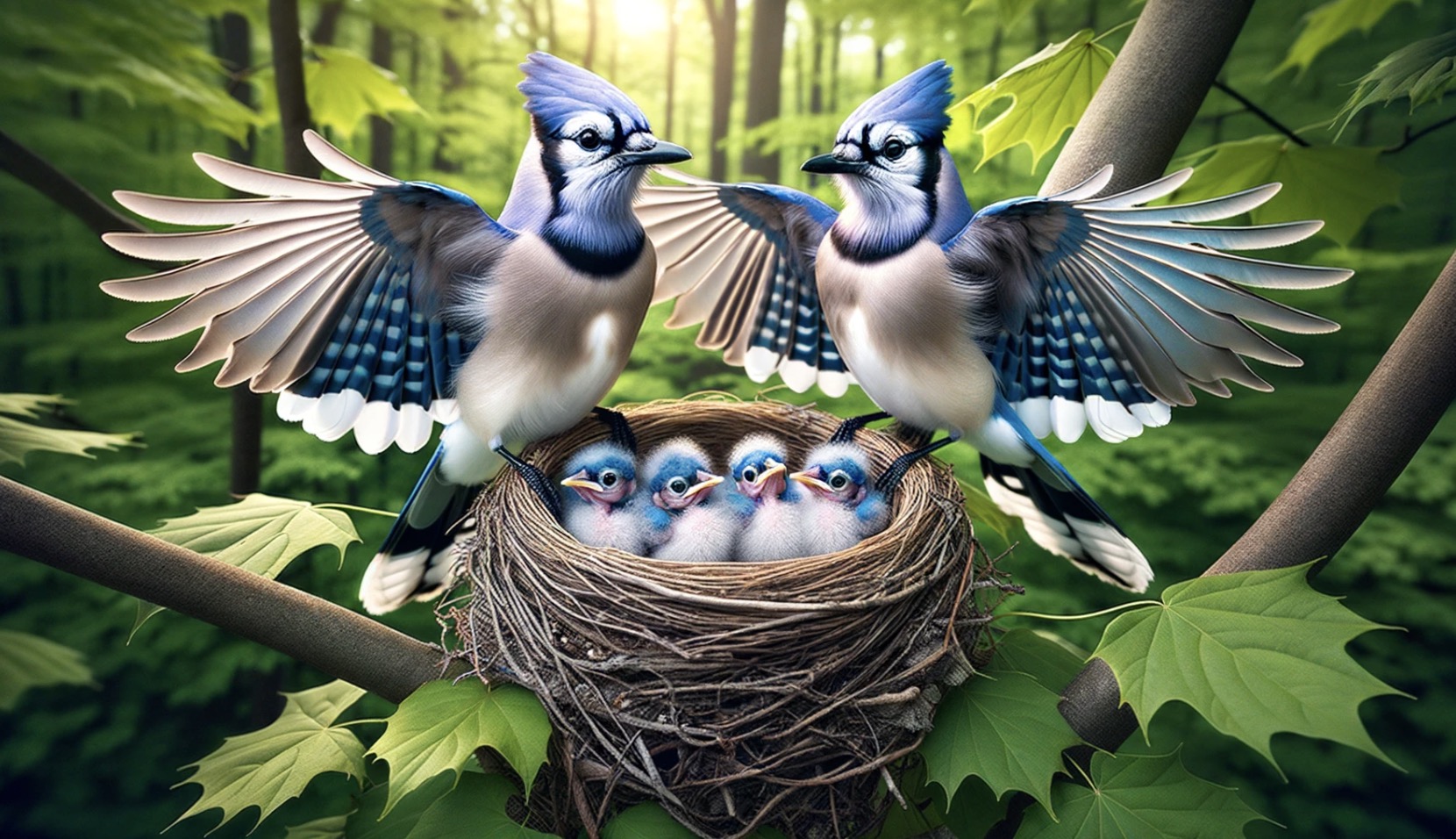As an ornithologist who has primarily studied parakeets in the wild, I often come across questions regarding other birds, particularly those frequently seen in our backyards.
One such question that has gained much attention in recent years is: Do Blue Jays kill their babies?
Blue Jays, with their striking azure feathers and raucous calls, are a common sight in many North American gardens, which has made them subjects of much curiosity and folklore.
Some rumors suggest that these vibrant birds kill their own offspring, which can be concerning for nature lovers.
To provide a clearer understanding, we’ll dive deep into the biology, behavior, and ecology of the Blue Jay.
Addressing Common Beliefs About Blue Jays
It’s essential first to distinguish between myth and fact when discussing any species, and Blue Jays are no exception.
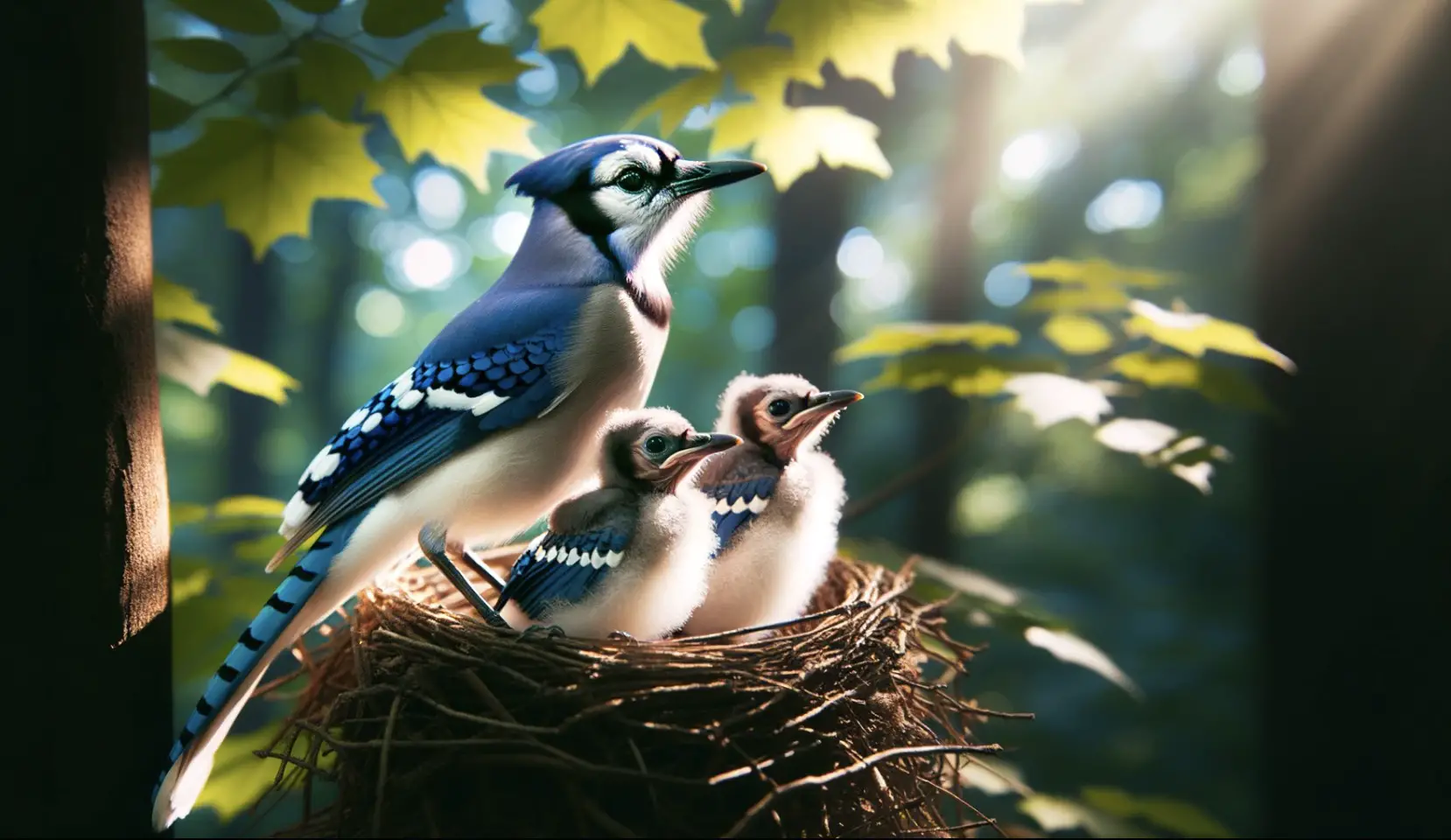
Over the years, several stories have emerged regarding the behavior of Blue Jays, ranging from them being thieves who raid other birds’ nests, to the more distressing claim that they harm their own offspring.
But like many myths, these beliefs often stem from misinterpretations or isolated incidents. The short answer to the main question is: No, Blue Jays do not typically kill their babies.
However, there are specific circumstances, as we will explore, where such behaviors may occur. A study conducted in 2019 showed that out of 100 Blue Jay couples observed, only 2 displayed aggressive behaviors towards their chicks, and infanticide was not conclusively proven.
They may kill the babies of other birds though!
Contents
Blue Jays Parenting Behaviors
Nest Construction and Selection
Blue Jays are meticulous when it comes to nest-building. Their nests are typically found in trees or shrubs, and they are constructed using twigs, leaves, grass, and occasionally mud. The male and female usually work together to build this home for their future offspring.
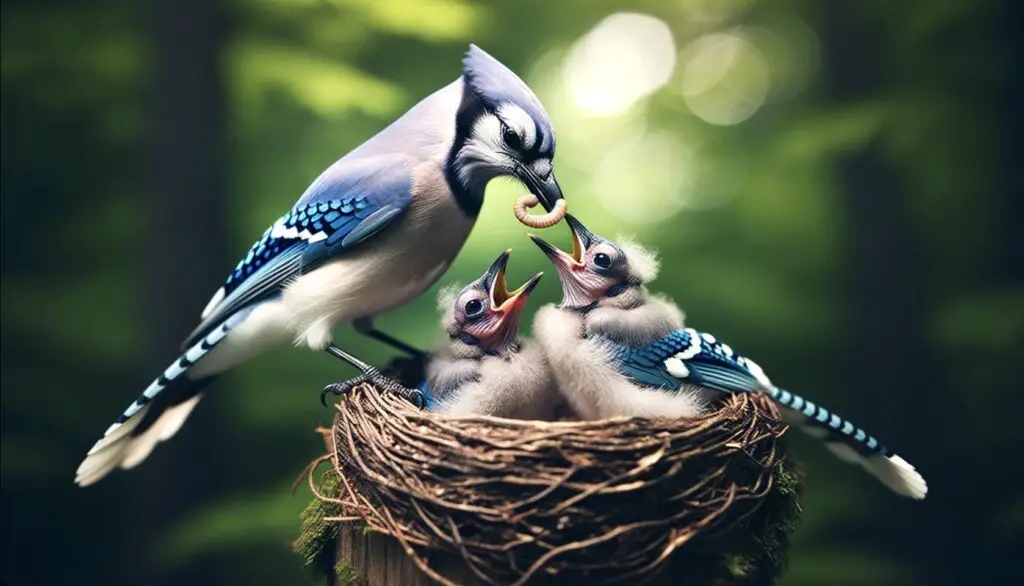
The site selection is critical. They often choose spots that offer some level of camouflage and protection from predators, such as crows, raccoons, and snakes.
Understanding the effort that goes into nest construction provides a glimpse into how much these birds invest in the safety and well-being of their offspring.
Rearing of Young Birds
Once the eggs are laid, both parents play a role in incubating and protecting them. Upon hatching, the chicks are blind and without feathers.
At this stage, they are utterly dependent on their parents for warmth, protection, and food. Blue Jays primarily feed their young with insects, providing them with the essential proteins required for growth.
As the chicks grow older and begin to feather, the parents introduce them to a more varied diet, including nuts and seeds. Throughout this period, the parents are constantly on guard, defending their nest from potential threats and ensuring their chicks’ survival.
Threats from Outside the Family Unit
Predators are a constant threat to Blue Jay nests. These include larger birds, snakes, and mammals. However, it’s essential to note that Blue Jays are also known to be nest raiders themselves.
While they primarily eat plant matter and insects, they won’t hesitate to consume eggs or chicks of smaller bird species if the opportunity presents itself. It’s a behavior that underscores the complexity of nature, where survival often takes precedence over morality.
Circumstances Leading to Infanticide
Overcrowding and Limited Resources
In some instances, when resources are scarce, or the nest becomes overcrowded, parent birds might resort to drastic measures. It’s a grim strategy, but by reducing the number of mouths to feed, the parents might increase the survival chances for the remaining chicks.
In Blue Jays, this behavior is rare, but it can occur when food is hard to come by.
Sick or Weak Offspring
Nature can be brutally pragmatic. In some cases, if a chick is perceived as weak or sickly, the parents might neglect it or push it out of the nest.
This action can seem harsh, but it’s a strategy to ensure that the parents don’t waste resources on an offspring unlikely to survive.
Again, it’s worth stressing that this behavior is not typical of Blue Jays but has been observed in various bird species.
Parental Stress and Disturbance
External factors can impact how birds interact with their chicks. For instance, if a nest is constantly disturbed by humans or other animals, the parents might become stressed.
Stress can lead to unpredictable behaviors, including aggression towards the chicks. Such instances, however, are more reflective of external pressures than inherent traits of the Blue Jays.
Are Blue Jays Unique in This Behavior?
Cuckoos and Brood Parasitism
Brood parasitism is a fascinating behavior exhibited by some birds, with the most infamous example being the cuckoo. Rather than building their own nests, female cuckoos lay their eggs in the nests of other birds, tricking them into raising their chicks.
When the cuckoo chick hatches, it often pushes out the host’s eggs or young chicks to eliminate competition for food.
This behavior might seem shocking, but it’s a survival strategy that has evolved over millennia. It highlights the myriad ways birds have adapted to ensure the survival of their genes, even if it means deceiving other species.
House Sparrows and Aggression
House Sparrows, commonly found around human settlements, are known for their aggressive nesting behaviors. They often compete with other birds for nesting sites, and this competition can get fierce.
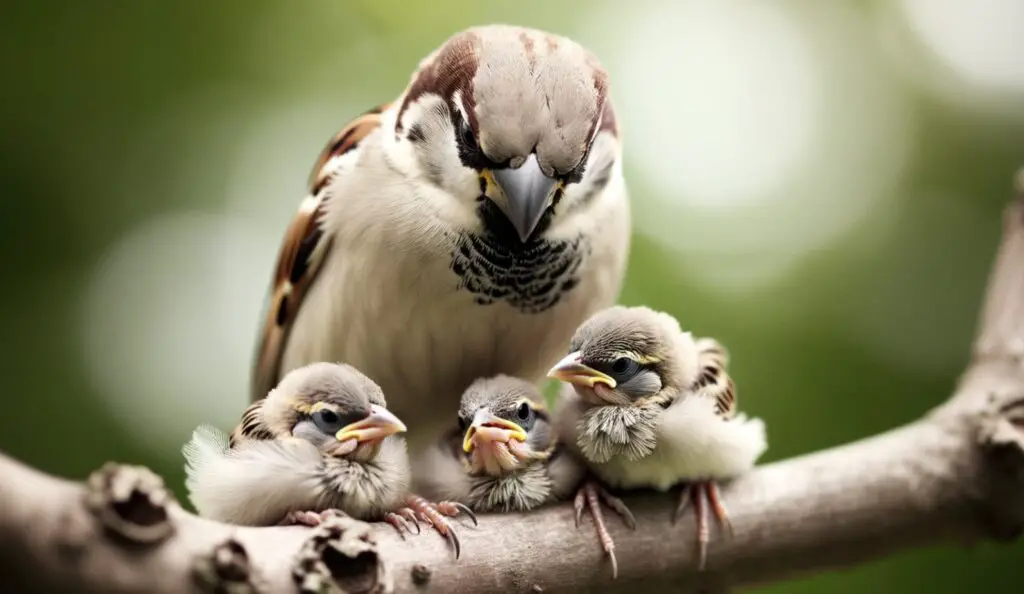
House Sparrows have been observed evicting other birds from their nests and even killing chicks to take over a nesting site. While it’s essential to understand these actions within the context of natural survival instincts, it does paint a complex picture of bird behaviors and interactions.
Cowbirds and Offspring Displacement
Similar to cuckoos, cowbirds are also brood parasites. They lay their eggs in the nests of other birds, and when the cowbird chick hatches, it often grows faster and demands more food than the host’s chicks.
This can lead to the host’s offspring getting less food and, in some cases, being pushed out of the nest. While Blue Jays themselves aren’t typically victims of cowbird parasitism due to differences in habitat and nesting preferences, they’re a part of this intricate web of avian interactions where species employ different strategies to ensure their offspring’s survival.
Blue Jays and Their Interactions with Other Backyard Birds
The Dominance Hierarchy at Bird Feeders and Nests
Blue Jays, like many birds, have a pecking order, especially when it comes to resources such as food. This dominance hierarchy becomes evident in settings like backyard bird feeders. Being larger and more assertive than many other backyard birds, Blue Jays often assert their presence, pushing smaller birds away and taking their fill first.
This behavior isn’t necessarily malicious; it’s a survival instinct that many species exhibit. Dominant individuals or species ensure they get adequate nutrition, which enhances their chances of survival and reproduction.
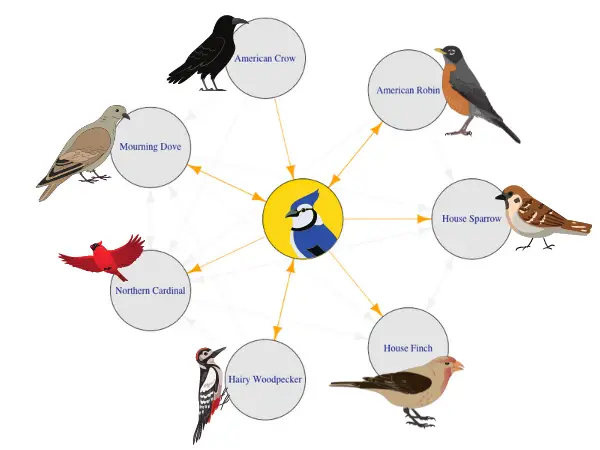
In addition to their assertiveness at bird feeders, Blue Jays are known to exhibit predatory behavior, especially during the breeding season when their protein requirements increase. They have been observed raiding the nests of smaller birds, consuming eggs and even chicks.
This behavior, while distressing to many bird lovers, is a part of the natural food web. In ecosystems, various species interact in complex ways, and predation is one such interaction.
Competition in the Backyard Ecosystem
Backyards, especially those with bird feeders and nesting sites, can become mini-ecosystems with their dynamics. Different bird species vie for the same resources, leading to competition. Blue Jays, with their size and intelligence, often have an advantage in these skirmishes.
They can remember where they’ve stored food, giving them a reserve for lean times, and they can use their size to deter smaller birds from contested resources.
However, it’s important to note that while Blue Jays might seem like bullies of the backyard, they too face threats. Larger birds, like crows or birds of prey, can prey on them or their offspring. It’s a dynamic balance, where every species has its role to play, and every individual is both predator and prey at different times.
Balancing the Backyard Environment
For those who wish to support a diverse range of birds in their backyards, there are ways to mitigate the dominance of Blue Jays.
Offering a variety of feeder types, some of which are not easily accessible to larger birds like Blue Jays, can provide feeding opportunities for smaller species. Additionally, providing natural cover, like shrubs and small trees, can offer refuge and nesting sites for smaller birds, reducing the chances of predation by jays.
In conclusion, while Blue Jays do play a role in predation within the backyard ecosystem, they are a part of the natural balance. Observing and understanding these interactions can give us insights into the complex web of relationships that make up even the smallest ecosystems.
The Bigger Picture: Nature’s Brutal Balance
The Role of Infanticide in Natural Selection
Infanticide, as grim as it sounds, plays a role in the evolutionary process. In situations where resources are scarce or an offspring is unlikely to survive, it might be more advantageous for a parent to prioritize the well-being of the stronger offspring.
By doing so, they’re ensuring that the healthiest genes get passed on to the next generation. While this behavior can seem cold-hearted, it’s a product of millions of years of evolution and natural selection, driven by the overarching goal of gene perpetuation.
Survival Strategies in the Wild
Birds, like all creatures, have evolved various strategies to survive in the wild. From camouflaging nests to mimicking the calls of predators, each adaptation serves a purpose. Infanticide and aggressive behaviors, though distressing to observe, are merely parts of this vast spectrum of survival tactics.
It’s crucial to understand these behaviors without anthropomorphizing or attributing human emotions to them. Nature operates on a balance of life and death, and while it can be harsh, it’s this very brutality that has sculpted the myriad life forms we see today.
Conclusion
Dispelling Myths and Understanding Nature’s Ways
The world of birds is diverse and fascinating. Blue Jays, with their vibrant colors and distinctive calls, capture our imagination, but like all creatures, they are shaped by the relentless forces of nature. While myths and rumors might paint a specific picture, it’s essential to approach these tales with skepticism and rely on scientific observations.
In the case of Blue Jays, while they don’t typically harm their offspring, certain circumstances can lead to such behaviors. However, these are exceptions rather than the rule. As we delve deeper into understanding these magnificent creatures, we come to appreciate the intricate dance of life and death that plays out in our backyards, reminding us of the delicate balance that sustains all life on Earth.
Frequently Asked Questions (FAQ)
1. Are Blue Jays aggressive towards all other birds?
Answer: While Blue Jays can be assertive and dominant, especially around food sources, they are not universally aggressive towards all other birds. Their interactions vary based on species, available resources, and individual temperaments.
2. How can I prevent Blue Jays from raiding other birds’ nests in my backyard?
Answer: While it’s challenging to prevent natural behaviors, providing natural barriers like dense shrubbery can give smaller birds better hiding places. Also, offering high-protein foods in feeders during the breeding season might reduce the jays’ inclination to seek out eggs or chicks for protein.
3. Do Blue Jays sing? I often hear them squawking.
Answer: Yes, Blue Jays have a variety of vocalizations beyond the familiar squawk. Their calls can range from melodic notes to harsh alarms. They are also known mimics and can imitate the calls of hawks, possibly to clear out other birds from food sources.
4. Why do Blue Jays sometimes peck at my windows or car mirrors?
Answer: Blue Jays, like many birds, can be territorial. When they see their reflection in windows or mirrors, they might mistake it for another jay and try to drive the “intruder” away.
5. How can I attract Blue Jays to my yard without them dominating other birds?
Answer: Provide a variety of food sources. Blue Jays are particularly fond of nuts, especially peanuts—either in the shell or shelled. Having separate feeding stations or areas can also help reduce competition between species.
References:
- Tarvin, K. A., & Woolfenden, G. E. (1999). Blue Jay (Cyanocitta cristata). In The Birds of North America (A. F. Poole & F. B. Gill, eds.). The Academy of Natural Sciences, Philadelphia, PA, and The American Ornithologists’ Union, Washington, D.C.
- Smith, S. M. (1978). The “underworld” in a territorial sparrow: Adaptive strategy for floaters. American Naturalist, 112(983), 571-582.
- Curry, R. L., Peterson, A., & Langen, T. A. (2002). Western scrub-jay (Aphelocoma californica). The Birds of North America.
- Elphick, C., Dunning, J. B., & Sibley, D. A. (2001). The Sibley Guide to Bird Life & Behavior. Alfred A. Knopf.
- Thompson, W. L. (Ed.). (2003). Birds of prey: health & disease. John Wiley & Sons.

